Howard Andrew Jones's Blog, page 35
February 15, 2016
Board Game Bonanza
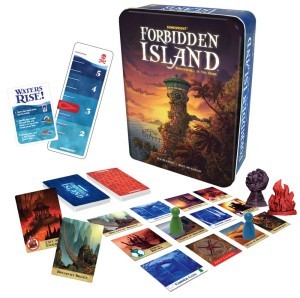 Well, not a bonanza, really, but my wife and I picked up Forbidden Island and Pandemic this weekend, and I’ve been researching other board games. We don’t have too many of the modern ones, as we’ve continued role-playing games over the years. A lot of the modern board games people rave about are sort of like “role-playing lite,” like Defenders of the Realm, and I figure if I want that feel I can just run a paper and dice role-playing game.
Well, not a bonanza, really, but my wife and I picked up Forbidden Island and Pandemic this weekend, and I’ve been researching other board games. We don’t have too many of the modern ones, as we’ve continued role-playing games over the years. A lot of the modern board games people rave about are sort of like “role-playing lite,” like Defenders of the Realm, and I figure if I want that feel I can just run a paper and dice role-playing game.
But there are scads of great looking modern games even apart from those. I’m most drawn to games with ancient civilization building and war themes, as you might expect, and other tactical games. I’ve heard wonderful things about Tigris & Euphrates for years but haven’t picked it up — I don’t imagine my wife would like the conflict aspect of it. (One of the reasons I have gotten into solitaire games is that I can play tactical scenarios that way.)
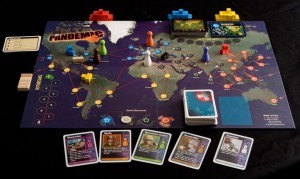 My wife is drawn to co-ops, some of which look pretty cool, and I spent some time Friday night and Saturday morning reading through scads and scads of reviews, trying to narrow things down. Was there a lot of conflict? Did it scale well from 2-4 players? I wasn’t interested in just the review score, but WHAT was said, and the biases of the reviewer.
My wife is drawn to co-ops, some of which look pretty cool, and I spent some time Friday night and Saturday morning reading through scads and scads of reviews, trying to narrow things down. Was there a lot of conflict? Did it scale well from 2-4 players? I wasn’t interested in just the review score, but WHAT was said, and the biases of the reviewer.
Anyway, now we have two new games in the house, and we discovered that the nearby game store (hard to believe, but there’s actually a cool store on our side of town!) allows you to check out a used game for 5 dollars for a week to see what it’s like, so we can try out Castles of Burgundy or Agricola or a host of others. If any of you out there have any suggestions, I’m all ears.
I was just reading a review of the co-op Freedom: The Underground Railroad while I finished breakfast. It looks good. It put me in mind of a book I read and re-read when I was a little boy of 6-8, about Harriet Tubman. I loved that book. Great atmospheric pictures and evocative prose, although it was for younger children and some of the concepts weren’t entirely clear. For instance, for years I misunderstood what the underground railroad really was — I thought it was literal, and there had been this vast network of secret train tunnels underground, pulled by some cool ultra fast trains. Man, if the abolitionists had possessed that technology, it would have been all over…
February 12, 2016
Rare Treasures
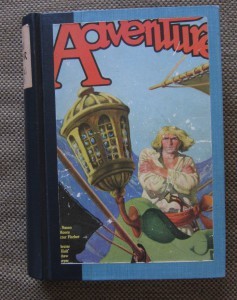 I’m still moving forward at a fast clip into the rough draft of my next book, although I’ve had a slow start this morning. Now that I’m not reading a long Conan story every week, and that the season is over for my daughter’s high school swim team, I have a little more time to read. On the docket soon are some books by friends and acquaintances, the first being an e-book I’m long overdue getting back to (sorry, Peter!).
I’m still moving forward at a fast clip into the rough draft of my next book, although I’ve had a slow start this morning. Now that I’m not reading a long Conan story every week, and that the season is over for my daughter’s high school swim team, I have a little more time to read. On the docket soon are some books by friends and acquaintances, the first being an e-book I’m long overdue getting back to (sorry, Peter!).
First, though, I’m finally finishing a read through of an anthology that’s a little like a mixed tape. I discussed my collection of one-of-a-kind pulp anthologies a few years ago if you want a little more information. Each was created, compiled, and hand sewn by pulp collector Al Lybeck. The one I’m reading right now includes several short novels:
“Libertatia” — Farnham Bishop
“The Snow Driver” — Harold Lamb
“Rusudan” — Harold Lamb
“Dregs of Defeat” — Georges Surdez
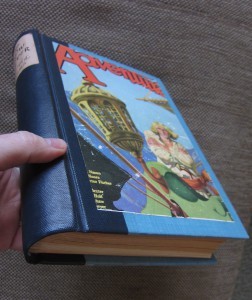
Thick with stories, hand sewn to the binding!
And a bunch of short stories:
“Buccaneer Trap” — F. van Wyck Mason
“Post Sargent” — Jacques Coeur
“The Place of Birds” — Lewis J. Rendel
“Swain Fostri” — Arthur D. Howden Smith
“The Last Legion” — Arthur D. Howden Smith
“The Unconquerable Jennings” — J.D. Newsom
“The War Cats of Dugan O’Day” — John Dorman
“Miracle of Madness” — Lewis J. Rendel
“Orlick the Eagle” — Kenneth Malcom Murray
That’s a WHOLE lot of pulp adventure in one anthology, hand picked by a gentleman who wanted to preserve his very favorite stories for re-reading. So far Lybeck seems to have excellent taste. I already knew the Lamb stories, naturally, and Smith’s “The Last Legion” from a collection of his “Gray Maiden” stories (about a fantastic sword handed down through the ages). But the rest? I’ve little idea. The Swain tale may be good or dull, depending upon how the dice fell, but it will have Vikings in it (Smith was inconsistent that way). And I know that the Surdez will probably be a French Foreign Legion adventure — he was famous for penning those in Adventure magazine, and is probably the only famous Adventure writer I haven’t read.
Anyway, it’s grand fun working my way through. Since I don’t know what any of the other tales will really be about, I’m going in expecting to be entertained and surprised, just as I might have long, long years ago if I were to pick up a copy of Adventure magazine from the stand. Except that these are “best of” volumes, so there are likely to be few duds apart from when (if) I disagree with Al’s judgement over a tale’s merits. I wish Al were still around so I could ask him more about why he’d picked these particular yarns.
These anthologies remain a glorious jewel of my book collection, one I’m savoring slowly. You can’t read TOO much pulp back to back, after all. And these being one of a kind, once I DO finish reading them, there simply aren’t any more.
February 10, 2016
Full Tilt Wednesday
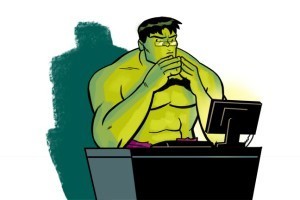 Drafting this new, eh, draft, is going so well I didn’t want to take too much time out to create a post for the day, but I did want to stop and thank all of you who joined in the Conan re-read. Bill and I enjoyed sharing our thoughts with all of you, and exchanging opinions.
Drafting this new, eh, draft, is going so well I didn’t want to take too much time out to create a post for the day, but I did want to stop and thank all of you who joined in the Conan re-read. Bill and I enjoyed sharing our thoughts with all of you, and exchanging opinions.
I also want to thank Bill, who’s simply a brilliant writer. His insightful comments were a huge factor in the success of this re-read. But then he’s a brilliant guy and it’s a pleasure to name him my friend. He’s been talking about getting back to fiction writing, and I’ve been trying to encourage him in that route. The rest of you should as well. The problem with being named “Bill Ward” is that there are apparently a whole lot of creative folks with the same name, which makes it hard to launch your writing career. If you perform a search for his work, you’re apt to turn up someone else. He may have to start drafting under a pseudonym.
Technical difficulties prevented me from sharing some interesting photos with you this morning. Any more, it seems it takes at least 15 minutes to get photos transferred from my camera to my computer. There’s just a huge slow down involved, and everything slows to a halt. Today it took 15 minutes and then it turned out that the photos hadn’t even been recorded somehow (no, there’s no lens cap to forget to remove). Seeing as how work slowed down to a drip during those first 15 minutes I wasn’t about to take 15 more to try it again. Maybe Friday.
It’s a little strange not to have to prep an essay about what I’m reading every Friday, and a little bit freeing as well. I’m reading further afield. Also, I’m experimenting with a refinement of my outline and drafting process that’s currently yielding great results. If it continues to work I’ll post details.
Right — back to drafting.
February 5, 2016
Conan Re-Read: Conclusion
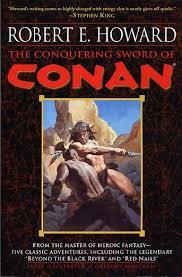 Bill Ward and I have just finished a re-read of every complete story of Conan the Cimmerian written by Robert E. Howard.
Bill Ward and I have just finished a re-read of every complete story of Conan the Cimmerian written by Robert E. Howard.
Howard: It’s hard to believe it’s been six months since we started this re-read. But then it’s hard to believe it’s over, and it’s hard to believe that there aren’t any more Conan stories. Such a fantastic character practically begs to have more adventures told about him, which is probably why the regrettable Conan pastiche industry popped up. Well, maybe not entirely regrettable, because I’ve read some I’ve really enjoyed. What’s regrettable is that for a long time they were packaged on equal footing with the real thing, or made available even when the real thing was out of print.
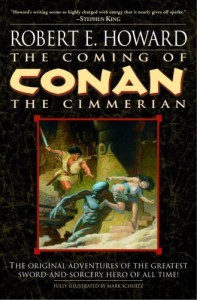 Bill: Ain’t that the truth. While I’m actually looking forward at this point to checking out the many pastiches I’ve never read — I’ve got a stack of Ace Conans that I’d started reading before we came up with the plans for this epic reread — I think the way REH’s stories were edited, diluted, manipulated, and concealed was contemptible. I can’t think of another author whose work was that famous who was treated so shabbily. I’m just happy we live in the age when, finally, most of his best work is available in easy-to-find volumes. The Wandering Star/Del Rey books, with their attention to restored texts and additional critical material and ephemera, are a beautiful and fitting tribute that was long overdue.
Bill: Ain’t that the truth. While I’m actually looking forward at this point to checking out the many pastiches I’ve never read — I’ve got a stack of Ace Conans that I’d started reading before we came up with the plans for this epic reread — I think the way REH’s stories were edited, diluted, manipulated, and concealed was contemptible. I can’t think of another author whose work was that famous who was treated so shabbily. I’m just happy we live in the age when, finally, most of his best work is available in easy-to-find volumes. The Wandering Star/Del Rey books, with their attention to restored texts and additional critical material and ephemera, are a beautiful and fitting tribute that was long overdue.
Howard: I’m in complete agreement there. Which pastiche are you planning to read? At this point I’ve worked my way through all of the well-recommended stuff, although it’s been so long since I read Wagner’s Road of Kings I might want to give that another try. Only recently, during this re-read, did I discover just how much fun the Roy Thomas Conan adaptions and pastiche can be. (For the curious, I discussed what I’d seen of the pastiche back here, and the article’s probably worth an update now that I’ve read a lot more of the comics.)
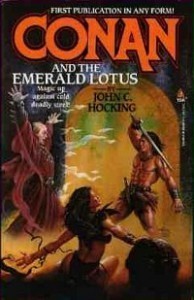 Bill: I’ve never read the deCamp and Carter pastiches, or the other stories by REH that deCamp Frankensteined into Conan tales. It’ll be a while before I jump into that series, though, as I’d be rereading all the REH tales again as well. As for other pastiches, I’ve only read a few — Wagner’s Road of Kings was good, and, of course, Hocking’s Emerald Lotus is terrific. I get the impression that a great many of the novel-length pastiches are pretty mediocre, however. Why not just reread REH in that case?
Bill: I’ve never read the deCamp and Carter pastiches, or the other stories by REH that deCamp Frankensteined into Conan tales. It’ll be a while before I jump into that series, though, as I’d be rereading all the REH tales again as well. As for other pastiches, I’ve only read a few — Wagner’s Road of Kings was good, and, of course, Hocking’s Emerald Lotus is terrific. I get the impression that a great many of the novel-length pastiches are pretty mediocre, however. Why not just reread REH in that case?
Howard: Right — and that’s where anyone should start. I love my long line of Del Rey Robert E. Howard books, beside hardbacks from the Robert E. Howard foundation, all upon a dedicated Robert E. Howard bookshelf. I used to have a whole smattering of different editions, many of which were second hand and pretty beaten up, but thanks to Del Rey and the foundation I’m been getting rid of a great many of my other collections.
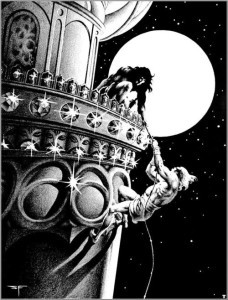 I came away from this re-read with an even greater appreciation for Howard’s work with Conan. I already number REH among my very favorite writers, and Conan among my favorite characters, so it’s no surprise that I liked what I found. But each time I revisit I’m confronted with the unassailable evidence of just how very good Howard truly was. And it seems as though, slowly but surely, there’s appreciation building about that. Unfortunately it also seems that the wider public isn’t much aware of the stories anymore. A lot of younger fantasy readers aren’t reading this good old stuff — to them I suppose stuff written in the ’90s is old stuff, and this is pliocene.
I came away from this re-read with an even greater appreciation for Howard’s work with Conan. I already number REH among my very favorite writers, and Conan among my favorite characters, so it’s no surprise that I liked what I found. But each time I revisit I’m confronted with the unassailable evidence of just how very good Howard truly was. And it seems as though, slowly but surely, there’s appreciation building about that. Unfortunately it also seems that the wider public isn’t much aware of the stories anymore. A lot of younger fantasy readers aren’t reading this good old stuff — to them I suppose stuff written in the ’90s is old stuff, and this is pliocene.
And that’s a shame, because so much about what makes fantasy fiction great is right here in the work of this astonishing pioneer. Anyone who’s going to be creating action scenes or huge battles or lost realms should make Howard’s fiction a first stop. And how about that pacing?
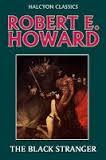 Bill: There’s a reason classics are classic. And we’ve looked at quite a few, Dunsany, Leiber, and now Howard. For a fantasy fan, let alone an author, to not have at least some familiarity with their work is both tragic and baffling. REH’s Conan, especially, I think, is the most accessible of them all — the pace, the intensity, the invention, and the character himself make for immediately rewarding fiction.
Bill: There’s a reason classics are classic. And we’ve looked at quite a few, Dunsany, Leiber, and now Howard. For a fantasy fan, let alone an author, to not have at least some familiarity with their work is both tragic and baffling. REH’s Conan, especially, I think, is the most accessible of them all — the pace, the intensity, the invention, and the character himself make for immediately rewarding fiction.
Howard: As far as the individual stories, I had only a few surprises. The most unpleasant was that “A Witch Shall be Born” was pretty weak. On the other hand, “The Hour of the Dragon” was even better than I remembered, and “The Black Stranger” was so much better than I recalled that it was a true joy to rediscover.
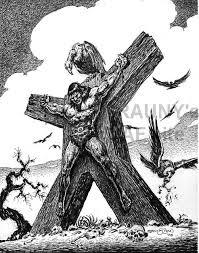 Bill: I certainly had a similar reaction to “A Witch Shall Be Born,” especially reading it right on the heels of so many strong stories. One of the best aspects of this reread for me was slowing down my approach to the stories by reading only one a week — we only ever worked ahead on multiple stories a few times, mostly they were all spaced out. This really let me pay attention to each piece as an individual. Most of my surprise moments were in realizing how much better and more vivid a particular story was that had previously been just a vague and undifferentiated memory for me. I suppose that’s the danger in reading a collection rather quickly; and I absolutely flew through these Del Rey’s when I first got them years ago. It was extremely rewarding to come back and give these pieces the focus they deserved.
Bill: I certainly had a similar reaction to “A Witch Shall Be Born,” especially reading it right on the heels of so many strong stories. One of the best aspects of this reread for me was slowing down my approach to the stories by reading only one a week — we only ever worked ahead on multiple stories a few times, mostly they were all spaced out. This really let me pay attention to each piece as an individual. Most of my surprise moments were in realizing how much better and more vivid a particular story was that had previously been just a vague and undifferentiated memory for me. I suppose that’s the danger in reading a collection rather quickly; and I absolutely flew through these Del Rey’s when I first got them years ago. It was extremely rewarding to come back and give these pieces the focus they deserved.
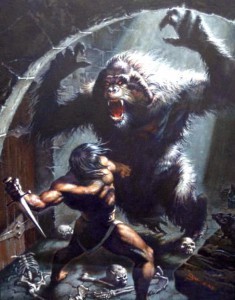 Howard: There’s a slight difference between a list of which Conan stories I think are best and which I’m most likely to re-read, and I don’t see any reason to give them both. “Beyond the Black River,” for reasons I’ve stated earlier, is among his best, but I’m in no hurry to revisit it.
Howard: There’s a slight difference between a list of which Conan stories I think are best and which I’m most likely to re-read, and I don’t see any reason to give them both. “Beyond the Black River,” for reasons I’ve stated earlier, is among his best, but I’m in no hurry to revisit it.
Bill: I agree with that distinction, for example I probably like “The God in the Bowl” more than I’d rate it on a pure quality scale. It’s perhaps too fine a point, and really not anything we need to belabor.
Howard: “The Tower of the Elephant” will probably always have first place on my most beloved list, owing to its brevity. It’s hard to fit in a quick re-read of the novel length The Hour of the Dragon or even “The People of the Black Circle” on a rainy Sunday afternoon.
Bill: Can you believe that “The Tower of the Elephant” is slightly longer than “The Phoenix on the Sword” and almost two thousand words longer than “The God in the Bowl?” There is a lot to be said for perfect pacing, it can warp time itself!
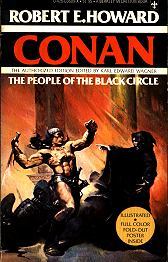 Howard: I hadn’t realized that! “The Tower of the Elephant” feels like the shortest of them all. Perhaps because it’s just so very finely crafted. I lose myself in it every time. In all fairness to some of the others, it probably edges them out, just a little, as my favorite. In the next tier are probably The Hour of the Dragon and “Black Colossus,” and very close on their heels the rest I enjoy including, “The Frost-Giant’s Daughter,” “The Phoenix on the Sword,” “The Scarlet Citadel,” “Queen of the Black Coast,” “Xuthal of the Dusk,” “Rogues in the House,” “The Devil in Iron,” “The People of the Black Circle,” “The Servants of Bit-Yakin,” and “The Black Stranger.” Add to that the opening half of “Red Nails” and one great scene from “A Witch Shall be Born.”
Howard: I hadn’t realized that! “The Tower of the Elephant” feels like the shortest of them all. Perhaps because it’s just so very finely crafted. I lose myself in it every time. In all fairness to some of the others, it probably edges them out, just a little, as my favorite. In the next tier are probably The Hour of the Dragon and “Black Colossus,” and very close on their heels the rest I enjoy including, “The Frost-Giant’s Daughter,” “The Phoenix on the Sword,” “The Scarlet Citadel,” “Queen of the Black Coast,” “Xuthal of the Dusk,” “Rogues in the House,” “The Devil in Iron,” “The People of the Black Circle,” “The Servants of Bit-Yakin,” and “The Black Stranger.” Add to that the opening half of “Red Nails” and one great scene from “A Witch Shall be Born.”
Bill: That’s the cream of the crop right there. Our lists are certainly similar. “Bit-Yakin” didn’t do as much for me, and I suspect I liked “Iron Shadows in the Moon” a lot more than you did. I also enjoyed “Beyond the Black River,” though I share some of your reservations there as well.
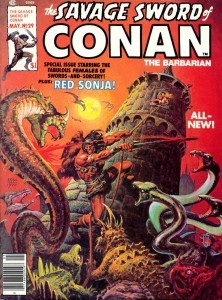 “The Tower of the Elephant” is practically the Platonic ideal of the sword & sorcery story. I think I’d call it my favorite Conan if there weren’t others that were just as strong, but achieve a different kind of effect. “The People of the Black Circle” is amazing, thirty-thousand words honed like a razor, exuberant yet completely under control. Both “The Scarlet Citadel” and “Black Colossus” are mini-epics in which REH manages to convey extraordinary battle scenes with comparatively few words (he also does this in some of his historicals — maybe a future reread topic!). “Queen of the Black Coast” has such a different feel to it, and it packs a real emotional punch and gets at the heart of the character of Conan, in many ways it’s lingered with me more than any other story. The Hour of the Dragon seems to gather up all the strands and put everything REH has learned and Conan has done into one story — it’s a masterpiece in the truest sense, the proof that REH ranks up there with the all time greats.
“The Tower of the Elephant” is practically the Platonic ideal of the sword & sorcery story. I think I’d call it my favorite Conan if there weren’t others that were just as strong, but achieve a different kind of effect. “The People of the Black Circle” is amazing, thirty-thousand words honed like a razor, exuberant yet completely under control. Both “The Scarlet Citadel” and “Black Colossus” are mini-epics in which REH manages to convey extraordinary battle scenes with comparatively few words (he also does this in some of his historicals — maybe a future reread topic!). “Queen of the Black Coast” has such a different feel to it, and it packs a real emotional punch and gets at the heart of the character of Conan, in many ways it’s lingered with me more than any other story. The Hour of the Dragon seems to gather up all the strands and put everything REH has learned and Conan has done into one story — it’s a masterpiece in the truest sense, the proof that REH ranks up there with the all time greats.
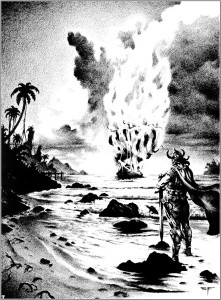 One of the chief pleasures of this reread was experiencing these stories in their proper order, so much so that it felt like discovering Conan and the world of Hyboria right alongside REH. The earliest stories in particular present a through-line of development for the series — a region seen on a map in “The Phoenix on the Sword” is the setting for “The Frost-Giant’s Daughter,” a line of description in “Queen of the Black Coast” becomes the title of “Black Colossus.” It’s like REH is moving so fast, has so much momentum, that he’s spinning off ideas left and right and leaving a trail behind him that anyone can follow. But we can also see when REH stumbles a bit, either in trying out a new mode of inspiration as he did in “The Vale of Lost Woman,” or in reducing Conan to a minor, if still the most interesting, character as in “A Witch Shall Be Born.” But no matter how much he experimented with the character and the “formula,” — or, even, how many times he used the same name for different characters in subsequent stories or repeated a plot point or the premise of a scene — it always seemed to me that there was a tremendous sense of connectedness between the tales. The cohesion, I think, is due to REH’s sincerity. He believed not only in what he was saying, but he believed in Conan.
One of the chief pleasures of this reread was experiencing these stories in their proper order, so much so that it felt like discovering Conan and the world of Hyboria right alongside REH. The earliest stories in particular present a through-line of development for the series — a region seen on a map in “The Phoenix on the Sword” is the setting for “The Frost-Giant’s Daughter,” a line of description in “Queen of the Black Coast” becomes the title of “Black Colossus.” It’s like REH is moving so fast, has so much momentum, that he’s spinning off ideas left and right and leaving a trail behind him that anyone can follow. But we can also see when REH stumbles a bit, either in trying out a new mode of inspiration as he did in “The Vale of Lost Woman,” or in reducing Conan to a minor, if still the most interesting, character as in “A Witch Shall Be Born.” But no matter how much he experimented with the character and the “formula,” — or, even, how many times he used the same name for different characters in subsequent stories or repeated a plot point or the premise of a scene — it always seemed to me that there was a tremendous sense of connectedness between the tales. The cohesion, I think, is due to REH’s sincerity. He believed not only in what he was saying, but he believed in Conan.
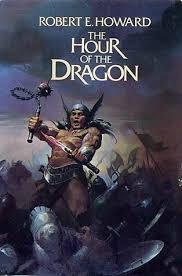 Howard: Very finely said, Bill. I don’t think there’s much I can add to that, although I think it’s that sincerity and belief that has made it possible for so many of the rest of us to believe in Conan as well.
Howard: Very finely said, Bill. I don’t think there’s much I can add to that, although I think it’s that sincerity and belief that has made it possible for so many of the rest of us to believe in Conan as well.
If you were going to suggest some stories for first time visitors to Conan, where would you point them?
Bill: Well, I think “The Tower of the Elephant” probably leaps to both our minds as a solid introduction, and there is probably no way you could go wrong with that. But it also occurred to me that, for many readers, short fiction is really sort of an alien indulgence — and with that in mind I’d probably recommend The Hour of the Dragon to a lot of readers, especially young ones, that just don’t quite get the short story thing, but love fantasy novels. As an introduction, it’s essentially all-inclusive — REH was even writing it with a completely new audience in mind, and he does a great job building the world and the character of Conan. I think it would convey just what sword & sorcery is all about, and the headlong pace is a good introduction to how the shorts stories work. There are many strong stories to choose from, though, and you could even tailor your selection based on the reader’s tastes; we’ve got everything from pirate stories and massed battles to double-dealing roguery and lost worlds. What do you think, are there a top three or so that you could recommend to just about anyone?
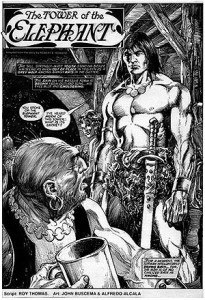 Howard: Growing up as I did reading and re-reading Swords Against Death (my first introduction to sword-and-sorcery) and then other short story compilations, I have a hard time accepting that some readers find short stories a foreign landscape. It’s as if they never want to watch an episodic tv show — they have to have a miniseries. (And those kids should get off my lawn!) That said, I think the choice of The Hour of the Dragon is an astute one for exactly the reasons you cite. If they were up for trying short stories I’d probably point them first at “The Tower of the Elephant,” and if it proved interesting, then either “Black Colossus” or “The People of the Black Circle” depending upon their own personal interests. I think once they were that far in they’d probably be good to go to explore on their own.
Howard: Growing up as I did reading and re-reading Swords Against Death (my first introduction to sword-and-sorcery) and then other short story compilations, I have a hard time accepting that some readers find short stories a foreign landscape. It’s as if they never want to watch an episodic tv show — they have to have a miniseries. (And those kids should get off my lawn!) That said, I think the choice of The Hour of the Dragon is an astute one for exactly the reasons you cite. If they were up for trying short stories I’d probably point them first at “The Tower of the Elephant,” and if it proved interesting, then either “Black Colossus” or “The People of the Black Circle” depending upon their own personal interests. I think once they were that far in they’d probably be good to go to explore on their own.
But then I’ve noticed in comments sections that some of our readers started their REH reading with “Red Nails” or even “Beyond the Black River,” a story that delayed my own entry into the REH fan club for a couple of extra years. In short, I just don’t know WHAT will work — I’d probably tailor those recommendations depending upon the reader. Even the weakest of the tales have strong points. There’s a little bit of magic in all of them.
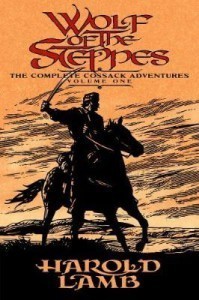 While not a grueling marathon by any stretch, Bill and I found ourselves a little taxed in the back half of this re-read, when many of the stories proved longer. We’re going to lay off any more re-reads until Spring. When we return, we’re talking about looking at some more Leigh Brackett, and then perhaps some Harold Lamb. I’m also tossing around the idea about visiting some other Robert E. Howard, but are there other old writers you’re interested in looking at, Bill? How about the rest of you?
While not a grueling marathon by any stretch, Bill and I found ourselves a little taxed in the back half of this re-read, when many of the stories proved longer. We’re going to lay off any more re-reads until Spring. When we return, we’re talking about looking at some more Leigh Brackett, and then perhaps some Harold Lamb. I’m also tossing around the idea about visiting some other Robert E. Howard, but are there other old writers you’re interested in looking at, Bill? How about the rest of you?
Bill: I think Clark Ashton Smith would be a good choice, and possibly a return to our old friend Lord Dunsany. We could perhaps instead look at an anthology series, such as Flashing Swords or Thieves’ World. Or we could do the unexpected and pick a classic collection from someone like Bradbury or Zelazny. I think I’d always be ready for more REH, though, and there’s plenty to choose from there.
Howard: Hmm. Clark Ashton Smith might be an interesting, and challenging choice. His fiction is so rich I usually can’t read more than a few in a row, but perhaps a shorter collection would be an interesting place to start. That said, I’ve been jonesing (see what I did there?) for another look at Lamb’s Cossack stories. The only difficulty there is that most of them stretch on to “People of the Black Circle” length. I wonder if we could alternate them with shorter works from others?
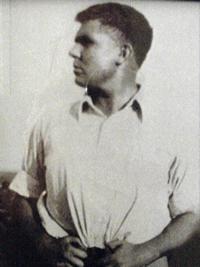
Robert E. Howard
Bill: The odd juxtaposition of CAS one week and Khlit the next just might prove to be a chocolate-in-my-peanut-butter moment. Weird thing is, in the case of our Conan re-read, we were sort of getting a bit of both of those kinds of stories in every tale. REH was truly an amazing writer.
Howard: No argument there. He was a trail blazer. And in a lot of ways, the rest of us are still sprinting to keep up.
See you all in a couple of months, when our re-read series continues with a new book or two! In the mean time, I’m sure I’ll keep blathering about cool books I’m reading, old pulp, the occasional game, and the writing life.
February 1, 2016
January Wrap-Up
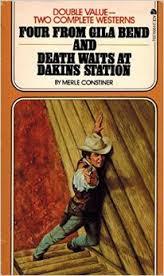 February’s here. That’s hard for me to believe. One twelfth of the New Year is already over, and it was a blur. But looking back I suppose it’s been a good month. I have managed to not be nearly as pedal to the metal and have been taking time to relax on many evenings, something that didn’t happen much the whole back half of 2015.
February’s here. That’s hard for me to believe. One twelfth of the New Year is already over, and it was a blur. But looking back I suppose it’s been a good month. I have managed to not be nearly as pedal to the metal and have been taking time to relax on many evenings, something that didn’t happen much the whole back half of 2015.
Over the weekend I finished my friend Ian Tregillis’ new novel in manuscript and found it delightful, and later I finished a short Merle Constiner novel. He has only a handful more that I haven’t read (well, 8 may not normally be considered a handful, but they’re all quite short) so I’m going to read something completely different and pace myself.
I discovered a great review of that Constiner novel just this morning and am attaching a link here — seems I’m not the only one who’s found an appreciation of this neglected western writer. I was thinking early today that with all the elements of mystery in all of Constiner’s books, and their emphasis on the lone, close-mouthed man doing right, that they share a lot of traits with some of my favorite hardboiled detective stories.
Work continues apace on the second novel of my new series, although it also continues on a continual revision pass on the first novel, as my wife works her way through it and finds little issues that needed to be addressed. I’m lucky to have a great first reader right here in the home!
January 29, 2016
Conan Re-Read: “Red Nails”
 Six months ago Bill Ward and I began a re-read of every Conan story that Robert E. Howard ever wrote and completed. Today we’re posting our discussion about the final one, “Red Nails.” We hope you’ll join in.
Six months ago Bill Ward and I began a re-read of every Conan story that Robert E. Howard ever wrote and completed. Today we’re posting our discussion about the final one, “Red Nails.” We hope you’ll join in.
Bill: “Red Nails” is the last Conan story Robert E. Howard wrote, and it is perhaps a little difficult to look at it without that fact coloring the discussion to some extent — particularly after reading and talking about every other story in the Conan canon! A lot could be (and has been) said about REH’s state of mind at this time, the period leading up to the final year of his life, a year in which he wrote no fantasy at all. Arguably, the final Conan stories seem to show a bit of a distancing between REH and his creation, either through characterization such as in “Beyond the Black River,” or by focusing on other point-of-view characters such as in “The Black Stranger” or, most starkly, “A Witch Shall Be Born.” I think anyone reading “Red Nails” who has some awareness of REH’s life will at some point stop to ponder the question of whether or not he ever intended to return to Hyboria, or if perhaps the Cimmerian himself had run out of stories to dictate at REH’s shoulder. Whatever the answer, “Red Nails” does serve as a fitting farewell to the character and world that have become so dear to so many, offering a story of adventure, intrigue, and exoticism that, while it may not quite be up to the standards of the very best in the series, delivers on all of the promises inherent in a Conan yarn while at the same time offering a few surprises as well — most notably in the character of Valeria.
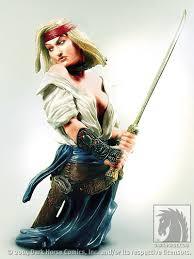 Howard: She’s the closest we’ve come for a long time to seeing someone who is Conan’s equal partner… although she’s not, really. She IS the most formidable of the women who appear in Robert E. Howard’s Conan stories, though not in all his work. It’s difficult to imagine Sonya from “Shadow of the Vulture” or Dark Agnes being captured multiple times over the course of a single adventure. That said, there’s no denying Valeria is the second most capable character in the entire story, second only to the amazing Conan himself. Arguably he wouldn’t be alive at the conclusion if she hadn’t snagged his belt while he was fighting the dragon (he would have plummeted off the cliff or into its mouth), and it’s made clear multiple times just how dangerous she is with her sword.
Howard: She’s the closest we’ve come for a long time to seeing someone who is Conan’s equal partner… although she’s not, really. She IS the most formidable of the women who appear in Robert E. Howard’s Conan stories, though not in all his work. It’s difficult to imagine Sonya from “Shadow of the Vulture” or Dark Agnes being captured multiple times over the course of a single adventure. That said, there’s no denying Valeria is the second most capable character in the entire story, second only to the amazing Conan himself. Arguably he wouldn’t be alive at the conclusion if she hadn’t snagged his belt while he was fighting the dragon (he would have plummeted off the cliff or into its mouth), and it’s made clear multiple times just how dangerous she is with her sword.
It could be argued that Conan’s beloved Belit is the strongest of all the female characters he meets, although much of that strength is implied rather than witnessed directly in martial terms.
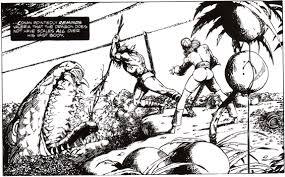 Bill: I think it’s interesting that Valeria and Belit are both pirates, though they embody different archetypes: Valeria is a swashbuckler, Belit a Pirate Queen. And I found a lot of satisfaction at the end of the story as Conan is about to set off into the unknown with a woman who is both a romantic partner, and a fellow-adventurer. Again, this is probably a case of adding unwarranted weight to the final moment in the final story, and of course we know that chronologically many more events will comprise Conan’s history, but as a final look at the Cimmerian I find this a happier end than, say, “Beyond the Black River.”
Bill: I think it’s interesting that Valeria and Belit are both pirates, though they embody different archetypes: Valeria is a swashbuckler, Belit a Pirate Queen. And I found a lot of satisfaction at the end of the story as Conan is about to set off into the unknown with a woman who is both a romantic partner, and a fellow-adventurer. Again, this is probably a case of adding unwarranted weight to the final moment in the final story, and of course we know that chronologically many more events will comprise Conan’s history, but as a final look at the Cimmerian I find this a happier end than, say, “Beyond the Black River.”
Howard: That’s a fine point. I’m glad we get a happier end than we’d have gotten if “Black River” were the last, or, worse, the middle-of-the-road “Man-Eaters of Zamboula.” “Red Nails” provides us with a lot of things to like, although I think that most of my favorite moments occur in the first third to a half of the tale. I like it quite a lot up to the point when they meet Olmec in the throne room, where my enthusiasm wanes a little. I had the same reaction on my last re-read, and had hoped that I’d simply been in a bad mood or something, which can be the only explanation for why I didn’t enjoy the excellent “Hour of the Dragon” as much on my 2nd read as I did on my 1st and 3rd. But no, I tore through the first part of “Red Nails” and couldn’t wait to see what happened next. And then it happened, and it wasn’t nearly as interesting as I had hoped.
But what a masterful opening, with Valeria finding the lay of the land, then mystery following upon mystery. The strange skeleton, the lost city, and the exotic environment are all incredibly compelling.
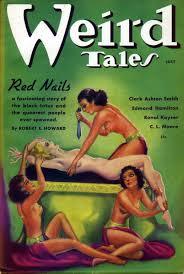 Bill: And Conan’s ingenuity in defeating the dragon! I do agree about the middle flagging a bit. I think this is a case where REH is deliberately setting out to write a three parter for Weird Tales, and things are stretched just a tad to accommodate that. I have no doubt he could have shortened the story by a quarter and maintained the same pace that he started with (although, if pressed, he might have ended up just cutting the opener and beginning the story like “Xuthal of the Dusk”), and he certainly could have lost yet another silly flogging scene, but I really appreciate that the action is squarely focused on Conan and Valeria throughout.
Bill: And Conan’s ingenuity in defeating the dragon! I do agree about the middle flagging a bit. I think this is a case where REH is deliberately setting out to write a three parter for Weird Tales, and things are stretched just a tad to accommodate that. I have no doubt he could have shortened the story by a quarter and maintained the same pace that he started with (although, if pressed, he might have ended up just cutting the opener and beginning the story like “Xuthal of the Dusk”), and he certainly could have lost yet another silly flogging scene, but I really appreciate that the action is squarely focused on Conan and Valeria throughout.
The setting, too, is really evocative. The city is its own closed environment, the current inhabitants hell-bent on killing each other by resurrecting old sorceries and monsters from the city’s past — I would have been happy with even more of that sort of thing. Thrown into the mix is a scheming leader, a sexy vampire, and a sympathetic warrior whose only taste of real humanity comes from his interaction with the outsiders, Conan and Valeria. Copious seasoning in the form of giant snakes, horrific torture devices, burning skulls, pipes of madness, and a kill-tally in the form of a black pillar studded with red nails. And, of course, the “ghost” of one of the original faction leaders (and the guy who invited the Tlazitlans into the city in the first place) returned to wreak vengeance on everyone left standing with a wand of mummification!
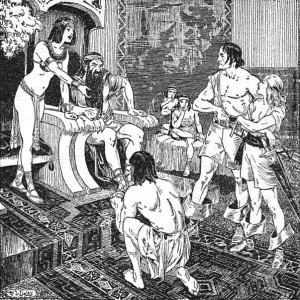 Howard: Yeah, the climax is pretty grand. But it was the entire opening that caught me, from their stand against the dragon to their flight across the plains, to the mystery of the city, described in wondrous detail. And then the fight between Valeria and the evil sorcerer/warrior wearing the skull, and the combat with the warriors… that was top-notch.
Howard: Yeah, the climax is pretty grand. But it was the entire opening that caught me, from their stand against the dragon to their flight across the plains, to the mystery of the city, described in wondrous detail. And then the fight between Valeria and the evil sorcerer/warrior wearing the skull, and the combat with the warriors… that was top-notch.
I was glad that Techotl didn’t end up betraying them as well — I would have liked just a half line of reflection from Conan or Valeria about them honoring his devotion or some such. I, too, could have done without the flogging scene, which didn’t add anything to the story apart from pleasing REH’s editor, Wright, one assumes. I found our vampiress more interesting in conception than execution. She sounds a lot cooler than she ends up being over the course of the story, and doesn’t hold a candle to the actual blood sucker we see in “Hour of the Dragon.” But you see, again, I can only compare REH to REH: “yeah, she was a sexy vampire, but she wasn’t as cool as that OTHER sexy vampire in the other Conan story…”
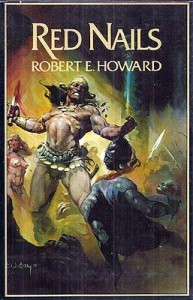 Bill: She’s no Akivasha, that’s true. But Tascela has a different role, and I like that she remains essentially mysterious until she flips the script on everything. She was a nice twist in a tale that could have easily just ended with Olmec fulfilling the same function. While in some ways the multiplicity of characters contributed to the back-and-forth pacing, in also kept ratcheting up the threat level and weirdness-quotient.
Bill: She’s no Akivasha, that’s true. But Tascela has a different role, and I like that she remains essentially mysterious until she flips the script on everything. She was a nice twist in a tale that could have easily just ended with Olmec fulfilling the same function. While in some ways the multiplicity of characters contributed to the back-and-forth pacing, in also kept ratcheting up the threat level and weirdness-quotient.
Howard: That pacing issue is probably why I actually prefer “The Slithering Shadow” in some ways to this stronger work. Howard was a better stylist by the time he wrote this, and the opening is stronger, the themes perhaps richer, but to me, that lesser tale has crackerjack pacing. On the other hand, it lacks Valeria, giving us instead a (mostly) insipid heroine. (And another whipping scene with a wicked foreign woman, naturally.) Side by side the two stories have a lot in common, apart from Thog, and there’s nothing in this tale as cool as Thog.
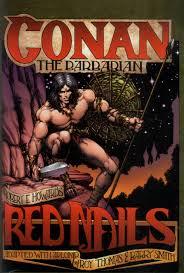 Bill: “Xuthal/The Slithering Shadow,” does have a lot to recommend it — and indeed my favorite part was the intense description of the combat with the aforementioned Thog. In “Red Nails,” Conan never really has a similar moment, or a similar antagonist, although the climax of course is quite desperate for him. Something that is stronger here, I think, is characterization. Admittedly Conan is becoming more and more superhuman as the stories progress (here he doesn’t sleep, his muscular calves prevent his bones snapping from what is in essence a bear trap, etc), but there are a lot of details about his career that call to mind a similar exploration of his past in “The Hour of the Dragon.” Repeatedly he makes note of some piece of information he has picked up about the Hyborian world in his far-roving, and again he describes himself as having been just about everything but a king. He even has a few characteristic lines, such as his conclusion that the people who had built the city led “disgustingly peaceful lives.” It just seems fitting that we get a look, even if it’s just a peek, at all these aspects of his character, pirate, thief, mercenary, and adventurer, one last time.
Bill: “Xuthal/The Slithering Shadow,” does have a lot to recommend it — and indeed my favorite part was the intense description of the combat with the aforementioned Thog. In “Red Nails,” Conan never really has a similar moment, or a similar antagonist, although the climax of course is quite desperate for him. Something that is stronger here, I think, is characterization. Admittedly Conan is becoming more and more superhuman as the stories progress (here he doesn’t sleep, his muscular calves prevent his bones snapping from what is in essence a bear trap, etc), but there are a lot of details about his career that call to mind a similar exploration of his past in “The Hour of the Dragon.” Repeatedly he makes note of some piece of information he has picked up about the Hyborian world in his far-roving, and again he describes himself as having been just about everything but a king. He even has a few characteristic lines, such as his conclusion that the people who had built the city led “disgustingly peaceful lives.” It just seems fitting that we get a look, even if it’s just a peek, at all these aspects of his character, pirate, thief, mercenary, and adventurer, one last time.
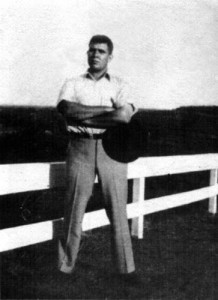
Robert E. Howard
Howard: You’re right about that final peek at the various facets of Conan’s career. And you’re also right about characterization, at least in the case of Conan, Valeria, and even poor Techotl. Olmec and Tascela, though, weren’t nearly as interesting. I loved Conan’s lines that you quote.
But I didn’t love the story. I liked it, and I loved parts of it, but that middle sagged. Maybe if I’d come to it never having read any other Robert E. Howard or Conan before I would have been more surprised, but once we got to the throne room I didn’t find the intrigue or the hidden problems of the society — or its history — particularly inspired. It felt very similar to some of the things I’ve read in other Howard stories (even if I haven’t seen all of those things in other Conan tales) here presented with less enthusiasm. It was almost as though he had real inspiration through the first portions of the story, but fell back on old patterns through the back half. Well, until that kick-ass conclusion.
That’s probably not how he himself felt about it, though, because judging by his letters he seemed quite interested in the topic of a decadent civilization and “lesbianism” — though he barely dips his toe into that particular subject, as it’s only very loosely suggested (Tascela clearly has male lovers). I thought the treatment of both subjects was superficial, especially when compared to his deeper look at civilization and barbarism two stories previous.
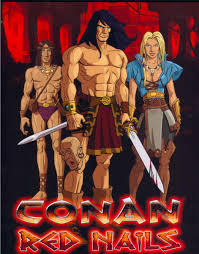
A great looking and sadly unreleased cartoon…
Bill: Despite its flaws, I came away really pleased with “Red Nails,” and I think it really is more than the sum of its parts. Structurally it can’t compare with a novella of similar length, “The People of the Black Circle,” but it does manage to handle a complicated plot better than “The Servants of Bit-Yakin” while showcasing REH’s frantic inventiveness in a way that is more cohesive than last week’s “The Man-Eaters of Zamboula.” But the more I think about it — and admittedly once again I may be influenced by the sad fact that this is indeed the final red nail driven into the pillar of the Conan canon — the more I’d just have to say that there’s magic in “Red Nails,” the same magic that all the best tales of the series possess. People have filled books, journals, and six months of blog post re-reads trying to put their finger on just what that magic is but, at the end of the day, it wouldn’t really be magic if you could completely explain it. And I can’t; I’m just happy we have what we have of it, and I hope to revisit it many more times in the future.
Howard: I’m not sure I’ll revisit this one, at least not completely. But I do agree that there’s magic here. I just wish I could have gotten swept away with this one the way I had with my favorites. I’m just going to hold onto that sense of magic and be glad for what we got. It’s not like the lamentable final episodes of the original Star Trek, which are so bad they’re cringe inducing.
We hope you’ll join us next week for a wrap-up discussion of all the stories we read!
January 27, 2016
Tregillis Triumphs Again
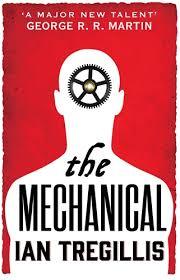 Remember how I said I’d held off reading the new IanTregillis books until I could have the second in my hand? He’s one of the few modern writers I find un-putdownable. And he did it to me again over the New Year holiday. I finished one and then reached for the other in short order. You like alternate history, intrigue, action, seasoned with a little of the fantastic? (In this case it’s mechanical men powered by alchemy).
Remember how I said I’d held off reading the new IanTregillis books until I could have the second in my hand? He’s one of the few modern writers I find un-putdownable. And he did it to me again over the New Year holiday. I finished one and then reached for the other in short order. You like alternate history, intrigue, action, seasoned with a little of the fantastic? (In this case it’s mechanical men powered by alchemy).
Then Tregillis will please you. Mightily. Get thee forth and read them.
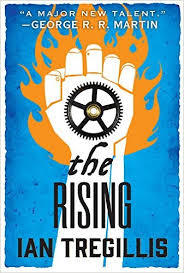 Here’s the cool thing, at least for me. Because I’m friends with Ian, I get to read the third book before it goes to press. As a matter of fact, I’m reading it THIS WEEK! Ha ha! Ah, the benefits of being a pro author. That, and all the sport scars and pirate gold. Oh, and the mansion.
Here’s the cool thing, at least for me. Because I’m friends with Ian, I get to read the third book before it goes to press. As a matter of fact, I’m reading it THIS WEEK! Ha ha! Ah, the benefits of being a pro author. That, and all the sport scars and pirate gold. Oh, and the mansion.
January 25, 2016
Snow Dogs
 Every morning I head out to feed the horses. Lately I not only feed the horses in the morning but muck the stalls, because my teenaged daughter is so busy with her school work and various team activities that she doesn’t have time to join me for afternoon mucking.
Every morning I head out to feed the horses. Lately I not only feed the horses in the morning but muck the stalls, because my teenaged daughter is so busy with her school work and various team activities that she doesn’t have time to join me for afternoon mucking.
Anyway, this morning the snow had been on the ground long enough to be wet rather than dry, and the shelter dog we’re pretty sure is a husky/german shepherd mix was eager to play. She loves the snow and cold weather. She’s one of the brightest dogs I’ve ever owned, and understands dozens of human words. Yet she’s never really caught on to fetch. For her, fetch is more like seek and destroy, which makes snowball catch one of her very favorite games. She was actually waiting on the back stoop for me to come out, and then led me off towards the snow, in case I was too stupid to clue in (she does the same thing when she needs food or water).
I dutifully packed up the snow into a snowball while she gamboled about, then tossed it into the air. Not too far, because then it would fragment and wouldn’t be nearly as much fun (because it wouldn’t be assembled in a ball to DESTROY). Ideally she prefers me to lob it in the air within ten feet so she can catch and devour it. Then she tears back for me to do it again.
I did this for a few minutes, then all the way down to the barn (we have an invisible fence so she doesn’t get near the chickens, whom she will also seek and destroy). Then she was waiting for me upon my return so I could hurl additional snowballs all the way back up. Oddly enough, our other dog, a Grand Pyranees/Golden retriever mix (another shelter dog) doesn’t understand fetch OR seek and destroy. She just sort of looks confused when you toss either a ball or a snowball. But then she’s probably the most intellectually challenged dog I’ve ever owned…
Hmm. Well, I was going to talk some about outlining today, but I think I’ll just end this canine reflection and get to work.
January 22, 2016
Conan Re-Read: “The Man-Eaters of Zamboula”
 Today, on the 110th anniversary of Robert E. Howard’s birth, Bill Ward and I are reading through the Del Rey Robert E. Howard collection The Conquering Sword of Conan. This week we’re discussing “The Man-Eaters of Zamboula,” sometimes known as “Shadows in Zamboula.” We hope you’ll join in!
Today, on the 110th anniversary of Robert E. Howard’s birth, Bill Ward and I are reading through the Del Rey Robert E. Howard collection The Conquering Sword of Conan. This week we’re discussing “The Man-Eaters of Zamboula,” sometimes known as “Shadows in Zamboula.” We hope you’ll join in!
Howard: Last week I suggested that this one was a bit of a dud, and while that might not have been entirely fair, I still don’t think it’s likely to be anyone’s favorite Conan story. Unlike “The Black Stranger,” though, it was published in Robert E. Howard’s lifetime in the pages of Weird Tales, by its editor Farnsworth Wright. And you can surely feel Howard playing to Wright’s favorite themes. Namely the sexy damsel in distress. You’ll note that she begins the story entirely naked and never once dons a stitch of clothing. It wouldn’t be so bad if it weren’t so gratuitous. You add that to some rather uncomfortable descriptions of the cannibals, the somewhat stilted opening, and the inn/cannibal trap and the result is less than stellar.
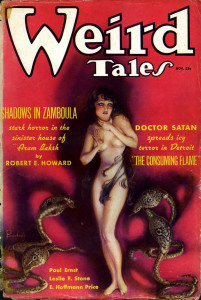 Bill: As soon as I read the Dance of the Cobras, I knew it was Weird Tales cover material. I see I was not mistaken…
Bill: As soon as I read the Dance of the Cobras, I knew it was Weird Tales cover material. I see I was not mistaken…
Howard: Hah! Right. On the other hand, it’s not completely without merit, and I’d still rank it above “A Witch Shall be Born,” apart from the fact that it doesn’t have a single scene that can approach “A Witch Can be Born’s” best moment.
Bill: I agree, it’s a firmly middle-of-the-road experience, one that reminds me of stories like “The Devil in Iron” and “Xuthal of the Dusk,” though not quite measuring up to either of them in my opinion. At one point in the story I was wondering why Conan was allowing himself to be led around by the nose by a woman purely in the hopes of getting into her pants, which was, thankfully, explained at the end — but then I realized he was instead being led around by the plot. And I suppose that’s my chief criticism, that this is a very plot-driven piece that never really feels like it has much weight to it.
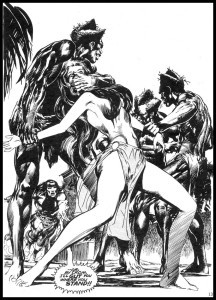 Howard: I have to agree. It definitely feels less like Conan makes the story happen and more that the story is happening TO him. And I agree that it doesn’t hold up to some of the other fun, lighter ones we’ve read earlier. On the other hand, there are some cool bits. I like how Conan, upon stopping his killer, immediately goes to seek out the inn’s owner to get revenge. That revenge is delayed when he hears a woman screaming for help, but as soon as THAT is dealt with — the entire rest of the story, I mean — he immediately resumes his quest for vengeance, settling it in quite grisly fashion. That was in keeping with the Conan we know and love, and was nicely handled as well.
Howard: I have to agree. It definitely feels less like Conan makes the story happen and more that the story is happening TO him. And I agree that it doesn’t hold up to some of the other fun, lighter ones we’ve read earlier. On the other hand, there are some cool bits. I like how Conan, upon stopping his killer, immediately goes to seek out the inn’s owner to get revenge. That revenge is delayed when he hears a woman screaming for help, but as soon as THAT is dealt with — the entire rest of the story, I mean — he immediately resumes his quest for vengeance, settling it in quite grisly fashion. That was in keeping with the Conan we know and love, and was nicely handled as well.
Bill: Indeed, I knew Aram Baksh was going to be in some serious trouble before the end of the story, and Conan did not disappoint. I thought Conan’s reasons for staying at the Cannibal Court Motel in the first place seemed flimsy, but in retrospect I think that was colored more by my expectations than what is in the text. This is clearly a younger and more reckless Conan than the one we’ve been seeing in these later stories. And he really didn’t receive any warning until it was already too late (his Zuagir friend should have offered Conan lodgings if he was so concerned!), and Conan always was the kind not to concern himself unduly with things until they are right in front of him.
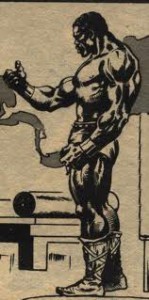 Howard: Right. There are several other things I like: that Conan knew that the ring was valuable all along was a nice little surprise, but I particularly liked his death duel with the strangler priest. I recall a critic complaining once that Conan calls “mesmerism!” because mesmerism as a term wouldn’t be invented for thousands of years. It’s a stupid criticism. One assumes that everything these characters say must be translated from some proto-dialects. It’s not as though they’re wandering around speaking English, after all.
Howard: Right. There are several other things I like: that Conan knew that the ring was valuable all along was a nice little surprise, but I particularly liked his death duel with the strangler priest. I recall a critic complaining once that Conan calls “mesmerism!” because mesmerism as a term wouldn’t be invented for thousands of years. It’s a stupid criticism. One assumes that everything these characters say must be translated from some proto-dialects. It’s not as though they’re wandering around speaking English, after all.
Bill: Exactly, if “mesmerism” is a problem then every anachronism in the stories is a problem; it’s nonsensical. I too enjoyed the “choke-off” with Baal-pteor, the Strangler of Yajur. It was extremely satisfying when Baal-pteor boasted of his long years of strangulation only to have Conan return nothing but contempt prior to breaking the villian’s neck: “Did you deem yourself strong, because you were able to twist the heads off civilized folk, poor weaklings with muscles like rotten string?” Conan, as it turns out, put his practice in with Cimmerian bulls before he’d even attained manhood.
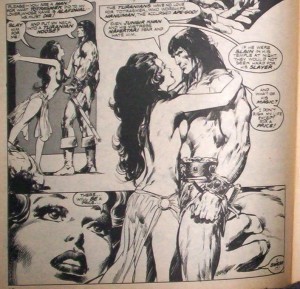 That scene does bring to mind another minor criticism of the story, at least when one contrasts it with the best of Conan, as we necessarily must. In a story like “People of the Black Circle” we are treated to an inventive and large array of magics, but everything still feels organic to the setting and story. Here, REH is inventing again with a red-hot fury, but I think the magic and marvels feel extravagant and not really anchored by the setting or characters. That doesn’t mean I don’t enjoy globes of illusion or urns of smoke-snakes or, even, a borderline-farcical magnetic table, but I can’t really believe in them, as presented, the way I do Khemsa’s spider-ball or the death staves of the Khitan assassins that pursued Conan in “The Hour of the Dragon.” Instead of mythically resonant, they are — and this is no bad thing — a fun pulp convention.
That scene does bring to mind another minor criticism of the story, at least when one contrasts it with the best of Conan, as we necessarily must. In a story like “People of the Black Circle” we are treated to an inventive and large array of magics, but everything still feels organic to the setting and story. Here, REH is inventing again with a red-hot fury, but I think the magic and marvels feel extravagant and not really anchored by the setting or characters. That doesn’t mean I don’t enjoy globes of illusion or urns of smoke-snakes or, even, a borderline-farcical magnetic table, but I can’t really believe in them, as presented, the way I do Khemsa’s spider-ball or the death staves of the Khitan assassins that pursued Conan in “The Hour of the Dragon.” Instead of mythically resonant, they are — and this is no bad thing — a fun pulp convention.
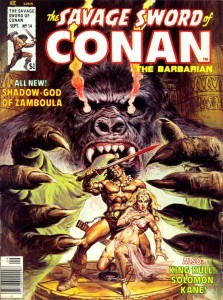 Howard: I have to agree. This was fun, but it wasn’t immersive, and it doesn’t fall in the same camp as “People of the Black Circle” at all.
Howard: I have to agree. This was fun, but it wasn’t immersive, and it doesn’t fall in the same camp as “People of the Black Circle” at all.
Bill: At the end of the day, “The Man-Eaters of Zamboula” is a fun if not particularly powerful story, and another of the lesser Conan pieces that really only suffers because it must be compared with the best of what REH can do — and that’s just about the highest bar of comparison I can imagine. After several more experimental kinds of pieces it’s a return to a young, almost careless Conan adventuring through a more typical Hyborian Age exotic setting, a naked princess by his side and villainous magic all around him.
Howard: Not that there’s anything wrong with that. It just is hard to compete with REH at his very best. Even REH himself has a hard time doing it. Interesting, isn’t it, that so many of his imitators write stories like THIS and the other lesser ones, and few that are much like the standouts?
So ends the next to last Conan story ever written by Robert E. Howard. And we raise a goblet in appreciation of his 110th birthday!
Next week we look at the very last, “Red Nails.” Hope to see you here!
January 20, 2016
Solitaire Gaming
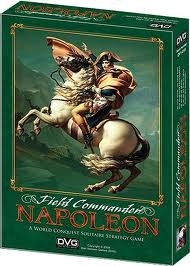 I dabble with solitaire board games from time to time, as I’ve mentioned occasionally here on my own site and at Black Gate. As I’ve said before, I blame the whole thing on John O’Neill, although Eric Knight deserves some blame as well because the two-player The French Foreign Legion was so much fun it converted me into a board game player.
I dabble with solitaire board games from time to time, as I’ve mentioned occasionally here on my own site and at Black Gate. As I’ve said before, I blame the whole thing on John O’Neill, although Eric Knight deserves some blame as well because the two-player The French Foreign Legion was so much fun it converted me into a board game player.
Unfortunately, there’s not much interest in these parts for board games, unless it’s Iron Dragon. I happen to think Iron Dragon is a lot of fun, but I also like tactical and strategic games, which hold no interest for my wife, which is why solitaire games like Empires of America from Victory Point Games or Field Commander: Napoleon from DVG find a way to my table, especially in the winter.
The other day I happened to mention the new Nemo’s War kickstarter to writer friend Ian Tregillis and it launched me on a search for others that I probably shouldn’t buy but want.
Here’s the list. Investigate at your own peril…
Howard Andrew Jones's Blog
- Howard Andrew Jones's profile
- 368 followers



